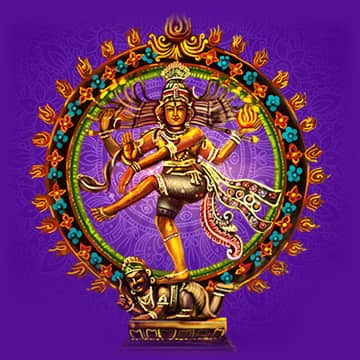Arudra Darshan is an auspicious day dedicated to Lord Shiva. It is a day to celebrate Lord Shiva’s cosmic dance, which symbolizes the five duties or Pancha Krityas: creation (Srishti), preservation (Sthithi), destruction (Laya), Concealment and revival (Tirobhav), and salvation (Anugraha). Arudra Darshan is celebrated mainly in South India, especially in Tamil Nadu. Here’s a look into when and why it is celebrated.
When Is It Celebrated?
Arudra Darshan Day is commemorated on the Thiruvadhirai star (Nakshatram). Ardra Nakshatram, also called Thiruvathirai, is the sixth among the 27 Nakshatrams. Arudra Darshan is held on a full moon (Purnima) night, accompanied by the Arudra star in Margazi month. It is among the longest nights of the year. This year, the Arudra Darshan falls on January 13. The Arudra Nakskatram starts at 11:24 am on January 12 and ends at 10:38 am on January 13.
Legend Of Arudra Darshan
As per a legend, Lord Shiva took the Nataraja avatar for his devotees Vyagrapaadar and Adi Shesha and performed the cosmic dance in Chidambaram. He (a seven-hooded snake) is the one on which Lord Vishnu rests in the Kshira Sagara (Milky Ocean). He wanted to see Shiva’s cosmic dance, and Shiva asked him to go to Thillai Forest by taking the Avatar of Patanjali (sage), where He would perform. Similarly, Vyagrapaadar was another Shiva devotee who performed penance to witness the dance. Lord Shiva did the Ananda Tandav to his two devotees at Chidambaram.
Another legend goes like this. A group of sages resided at Thillai who had magical powers wanted to control the Gods through their Mantras and rituals. Lord Shiva visited them to curb their ego and arrogance by taking the form of Bhikshandara, a mendicant. He was handsome, and the wives of the sages were enhanced. This angered the sages, and they created serpents through magic. But Bhikshandara converted those serpents into ornaments and wore them on the neck, waist, and locks. The sages then invoked a tiger, which Shiva skinned and wore as a cloth. Finally, they invoked Muyalakan, a demon who was immobilized by Shiva, and performed Ananda Tandava. When the sages realized who the mendicant was, they surrendered and fell to his feet.
Significance of Arudura Darshan
Lord Shiva in the Nataraja Avatar depicts the cosmic dance that symbolizes the five aspects of Divine control of the world, namely, Srishti, Sthithi, Laya, Tirobhav, and Anugraha. When Shiva dances, energy, matter, and sound are generated through the moves. The qualities manifest themselves in all spheres, and their atomic energy operates in harmony with the movement of Shiva’s body. During his dance moves, his leopard skin garment whirls, his hair tosses, and the serpent on his neck keeps uncoiling, making it difficult to recoil. The ganas, gods, goddesses, and all celestial beings come together to witness this dance. The dance symbolizes the cycle of making and destroying things and is where the energy for every particle in space comes from. The Arudra Darshan dance by devotees is a way to honor Ananda Tandava.
Arudra Darshan Celebrations
The grandest and the best celebration of Arudra Darshan is at Tamil Nadu’s Chidambaram Nataraja Temple. Lord Shiva’s cosmic dance is performed at the temple. Arudra Darshan is celebrated in Shiva temples throughout the world. The festival is also commemorated at the Tiruvannamalai Arunachaleswarar Temple. Here, Shiva is in the Nataraja form and the Ananda Tandava pose. The festivities are followed by a Brahmotsavam, which marks the end of the month of Margazhi.
The Thillai Nataraja Temple, also called the Chidambaram Temple, celebrates Arudra Darshan with great pomp. The temple was built in the 10th century by the Chola Kings, and Chidambaram was the capital. It represents the Akasa (sky) element at the center of the equator and is among the Pancha Bhoota temples.
This festival is also celebrated at the Tiruvarur Temple, Tiruvalankadu Temple, Kapaleeswarar Temple, and Nellaiappar Temple. It is also celebrated outside India in Singapore, Malaysia, South Africa, and Australia.
Arudra Darshan Benefits
Fasting on this day is believed to be very auspicious. Legend says that sage Munichakkar, Vyagrapada, and serpent Karkotaka were blessed with witnessing Lord Shiva’s dance after observing a fast. After keeping a fast, Sage Vyagrapada was granted a son called Upamanyu Vipular. Another legend says that a Brahmin who fasted on this day gains the fortune of seeing Mount Kailash in a godly flight.
The benefits of fasting on this day are:
- Removes difficulties, concerns, and fear Protects against enemies, hostile forces, and witchcraft
- Reduces malevolent planetary influences of the natal chart
- Provides success in wealth and material comforts
- Remove the ill-effects of past life deeds
- Resolves debt and relationship issues
- Improves health
- Clarifies actions and thoughts
Arudra Darshan holds great spiritual importance as it symbolizes Shiva’s dance of bliss of Ananda Tandava.
